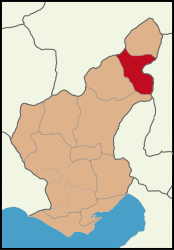Saimbeyli
Saimbeyli
Hadjin • Հաճն | |
|---|---|
District and municipality | |
 Partial view of the town | |
 Map showing Saimbeyli District in Adana Province | |
| Coordinates: 37°59′N 36°05′E / 37.983°N 36.083°E | |
| Country | Turkey |
| Province | Adana |
| Government | |
| • Mayor | Mustafa Şahin Gökçe (MHP) |
| Area | 989 km2 (382 sq mi) |
| Elevation | 1,050 m (3,440 ft) |
| Population (2022)[1] | 13,621 |
| • Density | 14/km2 (36/sq mi) |
| Time zone | UTC+3 (TRT) |
| Postal code | 01740 |
| Area code | 0322 |
| Website | www |
Saimbeyli, historically known as Hadjin (
.Saimbeyli is on the Göksu river (one of the sources of the Seyhan, in a valley between the forested mountains of Dibek and Bakır. There is a pass through the mountains from here to Kayseri and the valley is watered by many mountain streams.
History and monuments
The area probably has the foundations of Hittite settlements. There is no evidence at present that it was occupied in the Roman period, but it seems likely.
The fortress of Saimbeyli may be the medieval Badimon or perhaps the castle of Berdus, which appears on the Coronation List of
Opposite and below the fortress are the substantial remains of ecclesiastical and civilian architecture, which date from the 14th through the 19th century.[5] The monastic complex dedicated to St. James is perched on the side of a tall hill at the northwest end of the village. The monastery may have a 12th century foundation, but it was rebuilt in 1554 by Bishop Khatchadour.[6] In 1981 the foundation of an orphanage school was visible and only the east end of the large Church of St. James was standing. There was evidence of an underground crypt below the central apse of the church.
Population
At the beginning of the 20th century, Hadjin had an Armenian population of around 30,000. The Armenians had six churches, including the main Armenian Apostolic denomination, but also an Armenian Catholic and two Evangelical Armenian churches. The population worked in agriculture and various trades. They were subject to deportations and massacres during the Armenian genocide. After the end of World War I, in 1919, part of the Armenian population returned under the French Protectorate, but the French abandoned the city to Turkish rule, resulting in the Armenian rebellion and the eventual emptying of the city with the arrival of the Kemalist forces. The remaining Armenian population of Hadjin settled in various countries, notably Lebanon, Syria, France, the United States and Latin American countries. They established unions highlighting their city and achievements of its populations.
The Turkish authorities renamed the city Saimbeyli in the name of the Turkish military commander that retook the city under Turkish control.
In 1953, a town called
Composition
There are 28
Places of interest
- Near the village of Bahçeköyü there is a castle perched on a rock.
- Saimbeyli castle (known as Badimon in the Middle Ages)
References
- ^ TÜİK. Retrieved 12 July 2023.
- ^ Büyükşehir İlçe Belediyesi, Turkey Civil Administration Departments Inventory. Retrieved 12 July 2023.
- ^ "İl ve İlçe Yüz ölçümleri". General Directorate of Mapping. Retrieved 12 July 2023.
- ^ ISBN 0-88402-163-7.
- ^ Robert W. Edwards, "Ecclesiastical Architecture in the Fortifications of Armenian Cilicia: Second Report," Dumbarton Oaks Papers 37, 1983, pp.125–28, 130–31, pls. 10–17, 30–34.
- ^ Alishan, G. (1899). Sissouan ou l’Arméno-Cilicie. Description géographique et historique. Venice. pp. 174–177.
{{cite book}}: CS1 maint: location missing publisher (link) - ^ Mahalle, Turkey Civil Administration Departments Inventory. Retrieved 12 July 2023.

